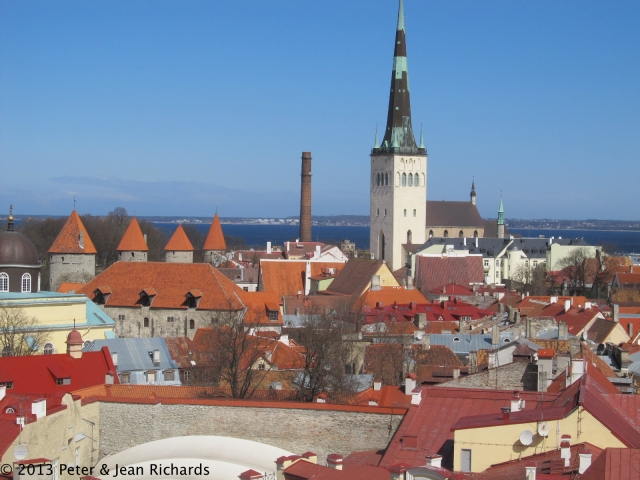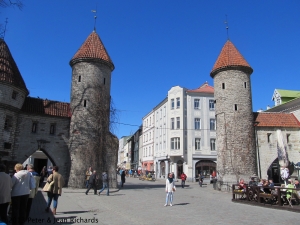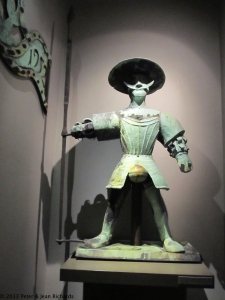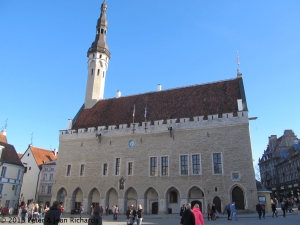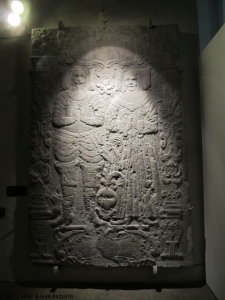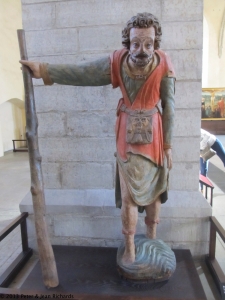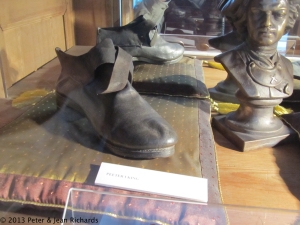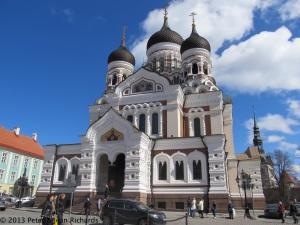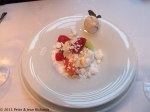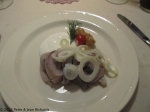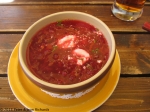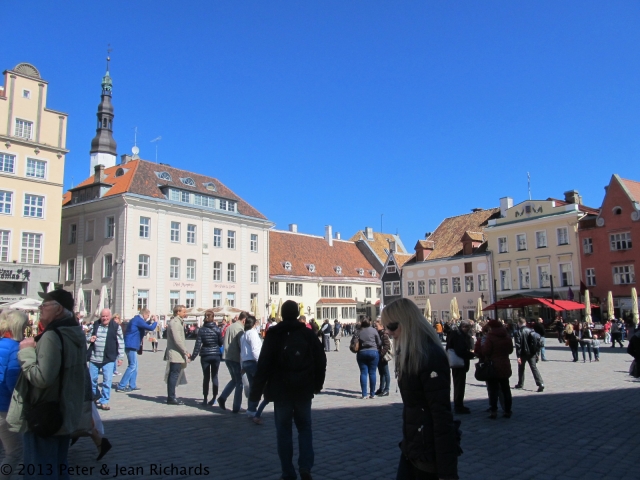By Jean and Peter Richards
In an era of theme parks promoting fantasy, Tallinn, Estonia, is the real thing — a fairy tale city of the Middle Ages.
The oldest capital in Northern Europe, once a thriving center of the Hanseatic League, now trades on its past and does it with style.
Tourism is largely centered within the relatively small upper and lower towns of the old Baltic seaside city; the community dedicates itself to it with myriad museums, cafés, eateries, souvenir shops and public spaces. The buildings wear pastel on their stone; the sometimes traditionally costumed people wear gaily decorated dirndls and vests.
Bright colors — red, yellow, the intense tangerine — lend warmth to signs on stone buildings rising on steeply cobbled streets layered with views across tile rooftops and turrets.
The warmth of a May day in this cold climate was as welcome as the new sign at the airport promoting it as “the world’s coziest airport.” It may not be a boast. Where else is the waiting area a “living room” with comfy sofas, club chairs, cheery end tables and a lending library with hundreds of book donated by locals?
The “cozy” campaign sets a tone appropriate to a place determined to make people welcome. Cheerfulness is evident in this 12th century enclave which has survived centuries of incursion by sheer perseverance. Aggression, from Viking raids to Soviet rule, has a long history in Estonia where current independence was only achieved in 1991 and European Union membership in 2004.
For the tourist, aggression manifests itself only meekly now as restaurant workers try to lure customers in on the lively, competitive town square where kindly “Old Thomas” sits high above the gothic windowed, slenderly steepled 15th century town hall. The weathervane is a guardian of charm and symbol of the spirit of Tallinn. It is said to have been created in the likeness of a 16th century peasant who excelled at a shooting contest, but was denied the prize because of his low status. Instead, he was educated and made permanent guardian of the town — a job fulfilled with honor and generosity. He became a beloved figure of the children to whom he gave candy. When he died, legend holds, his admirers raised the first weathervane so that children would always know he would be watching over them.
An earlier likeness sits in the very interesting Tallinn City Museum (Linnamuuseum) in a 14th century merchant’s house at 9 Vene, just down from the very comfortable, pleasant and convenient Telegraaf Hotel.
The clarity and continuity achieved on four floors tracing the history of Tallinn from pre-historic times to rule by Denmark, Sweden, Russia, Germany and the Soviet Union to recent independence is remarkable. This museum contrasts with the jumble that is the Estonian History Museum in Great Guild Hall which may have some of the worst designed exhibits anywhere.
On the second floor of the Linnamuuseum is a most unusual and wonderful display in which a cabinet is given over to the artifacts of Tallinn’s history with a shelf dedicated to each of the 11th to the 21st centuries. Shards of pottery and stone on the bottom shelf transit upward to the beautiful ceramics of the 18th century and finally to the ubiquitous trash of the 21st — a Coke can, a plastic food tub. It is history in a cabinet told in artifacts.
Tallinn’s old city also has another fine museum: the 13th century St.Nicholas Church, destroyed by bombs in 1944, was resurrected as the Niguliste Museum, a beautiful venue for intimate concerts and exhibitions of art. Just inside the entrance to “Ars Moriendi” (The Art of Dying) exhibition is a superb 1653 stone grave marker for Alexander von Essen dressed in chiseled finery.
The exhibit, drawing on Roman Catholic and Lutheran rituals, is devoted to the art of preparing for the afterlife. It includes a medieval treatise on how to do it with an amusing list of manners for funerals: toll the bell, follow the funeral director’s instructions, don’t act above your status and, above all, make sure the person is dead before the coffin lid is closed.
A realistic St. Christopher from the workshop of Tobias Heintze in 1634 is a sculptural highlight.
Social status in death is seldom more macabrely presented than in Bernt Notke’s 15th century Danse Macabre in 13 surviving panels and presumed to be a comment on plague which devastated Tallinn on several occasions.
One of the few modern notes in old Tallinn is a beautifully conceived stone monument to Estonian writer and Tsarist critic Eduard Vilde on an approach to the museum.
English speakers will have no problem communicating in Tallinn. Few visitors speak the Estonian Finno-Urgic tongue. A minority of Estonians are of Russian heritage and speak that language.
Russian heritage, however, has not been forgotten. Less than three kilometers from the old town, Kadriog draws locals and visitors to its sprawling park and cultural complex which includes the delightful little cottage Peter the Great built for his visits to Tallinn and the 18th century palace he had built for Catherine, now an art museum. The Estonian president’s elegant residence is within sight of a banal, but vast new contemporary cultural center at one end of the park.
The Alexander Nevsky Orthodox Church on Toompea, the upper level of the old town, is an exuberant confection and stands in stark contrast to Toompea’s spartan Lutheran Church. Pleasant as its streets are to wander, the real reason to make the steep and cobbled climb to the top is for the splendid view of the lower town and the bay.
The Russian legacy is also manifest in some of the town’s best food offerings at the very pleasant Telegraaf Hotel restaurant, Tchaikovsky, where the napkins are folded in the shape of swans and a trio often plays the composer’s works. The buckwheat imperial blini with white fish roe is superb as is the borscht. With a nod to the legendary ballerina, the Tchaikovsky offers its own sweet version of that decadent Australian meringue-based dessert, Pavlova.
“Grandmother’s place” was recommended for its authentic Estonian fare. It took two tries to get a table at the popular Restoran Vanaema Juures at 10 Rataskaevu in the lower town. The meal was lovingly prepared, but little to our taste. Herring in sour cream was very good, but duck breast and wild boar roasted to a fare-thee-well and surrounded by all manner of winter root vegetables missed its mark with us. We abjured the traditional dessert of a porridge made from rye, oat, barley, pea flour and sour milk.
We’ve often found that our antiques dealer colleagues world-wide like to eat well and share recommendations. One in Tallinn led us to Kuldse Notlsa Korts on Dunkei Street where we sat outside and were pleasantly surprised when lunch turned to be very good: beef liver paté wrapped in butter and served with dark bread, a light and refreshing beetroot soup, roast pork with roast potatoes and mild sauerkraut with shredded carrot, creamy sauce and a dollop of very sharp mustard. With coffees, the bill for two came to 36€, an inexpensive meal in Tallinn.
At Josephine’s on Vene, we succumbed to the sweet temptation of over-the-top slices of cake and a crumbly cheese curd concoction taken on the terrace with coffee and a view of busloads of tourists flocking to the main sights.
Tallinn may be a distant capital in Europe, but it is memorable — for its preservation, perseverance and pleasant people, not to mention that it was Estonian software developers who made communication by Skype possible.
We eased out of port with pleasant recollections on the Tallink ferry for the two hour trip across the Gulf of Finland to Helsinki.
Copyright © 2013 Jean and Peter Richards

